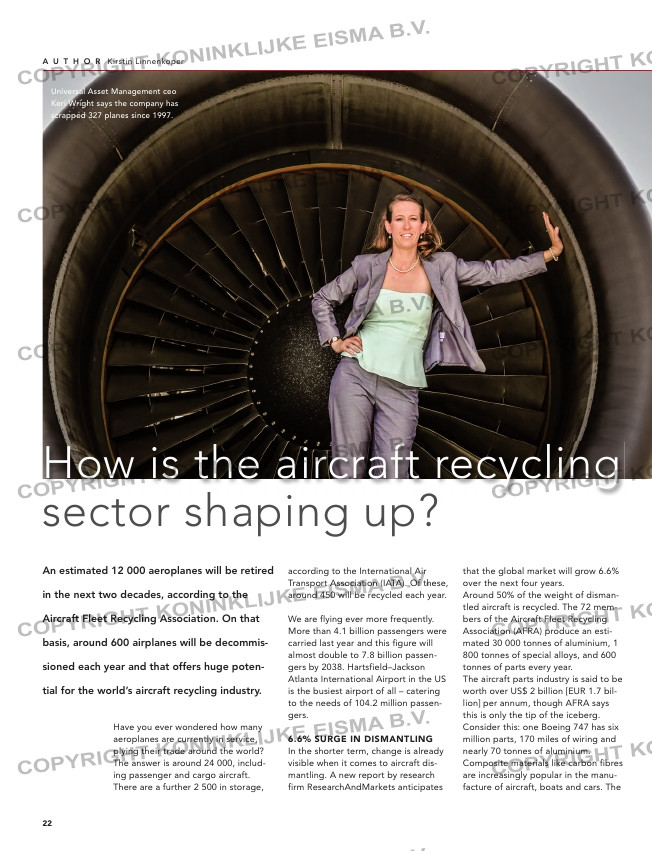Page 22 from: Autumn issue 2018

how is the aircraft recycling
An estimated 12 000 aeroplanes will be retired
in the next two decades, according to the
Aircraft Fleet Recycling Association. On that
basis, around 600 airplanes will be decommis-
sioned each year and that offers huge poten-
tial for the world’s aircraft recycling industry.
total volume of aerospace composites
is expected to exceed 70 000 tonnes
by 2024. This waste stream calls for
innovative recycling solutions.
what’s the incentive?
Recycling carbon fibre uses less than
5% of the electricity required to make
new carbon fibre and can be done at
around 70% of the cost, says Boeing’s
recycling specialist William Carberry.
But scrapping an aircraft is still not
cheap with the cost ranging from EUR
10 000 to EUR 100 000. On a positive
note, up to 85% of the aircraft can be
recycled, depending on the marque.
Even so, Carberry concedes: ‘An airline
may be able to recover up to US$ 7 mil-
lion for the engines, rotable [reusable]
parts and scrap metal but the remaining
value must be written off. In essence, it
is cheaper on an accounting basis to
leave the aeroplane in the desert than it
is to scrap and recycle it’.’ He points out
that the airline has been committed to
reaching (and is closing in on) a recy-
cling rate of 90-95% since 2012.
1 000 looPs Before
scraPPing
An important driver in the market
is the retirement of aircraft and
Have you ever wondered how many
aeroplanes are currently in service,
plying their trade around the world?
The answer is around 24 000, includ-
ing passenger and cargo aircraft.
There are a further 2 500 in storage,
according to the International Air
Transport Association (IATA). Of these,
around 450 will be recycled each year.
We are flying ever more frequently.
More than 4.1 billion passengers were
carried last year and this figure will
almost double to 7.8 billion passen-
gers by 2038. Hartsfield–Jackson
Atlanta International Airport in the US
is the busiest airport of all – catering
to the needs of 104.2 million passen-
gers.
6.6% surge in Dismantling
In the shorter term, change is already
visible when it comes to aircraft dis-
mantling. A new report by research
firm ResearchAndMarkets anticipates
that the global market will grow 6.6%
over the next four years.
Around 50% of the weight of disman-
tled aircraft is recycled. The 72 mem-
bers of the Aircraft Fleet Recycling
Association (AFRA) produce an esti-
mated 30 000 tonnes of aluminium, 1
800 tonnes of special alloys, and 600
tonnes of parts every year.
The aircraft parts industry is said to be
worth over US$ 2 billion [EUR 1.7 bil-
lion] per annum, though AFRA says
this is only the tip of the iceberg.
Consider this: one Boeing 747 has six
million parts, 170 miles of wiring and
nearly 70 tonnes of aluminium.
Composite materials like carbon fibres
are increasingly popular in the manu-
facture of aircraft, boats and cars. The
A U T H O R Kirstin Linnenkoper
22
Universal Asset Management ceo
Keri Wright says the company has
scrapped 327 planes since 1997.
thanks to Pamela
Can at least 85% of a retired aircraft’s components be safely and effectively
reused or recycled? That was the million dollar question Airbus engineers
asked themselves in 2006 when they established “PAMELA”, short for the
Process for Advanced Management of End of-Life-Aircraft project in the
south of France. The answer was a loud and clear ‘Yes!’ and helped push the
boundaries of modern aircraft recycling.
With EUR 2.4 million in funding from the European Commission, the Airbus
team applied recycling techniques from other industries to successfully
reduce aviation waste going to landfill to less than 15%, down significantly
from almost 50% when they started. Parts recycling went up from 60% to
85%. The ‘test subject’ was the passenger plane Airbus A380 MSN 5000,
which weighs around 280 tonnes.
This promising outcome resulted in the Tarmac Aerosave follow-up project,
which was able to boost recycling rates to 90% of the aircraft’s weight. A
company of the same name is currently co-owned by Airbus, Suez and tech
group Safran. Tarmac Aerosave operates sites in Toulouse and Lourdes
(France) and Terual (Spain), which have to date recycled more than 100 air-
craft – including Boeing 747s. On average, Tarmac is able to recycle 92% of
parts.
sector shaping up?
22-23-24-25_aircraftrecycling-latest.indd 22 20-09-18 14:18



